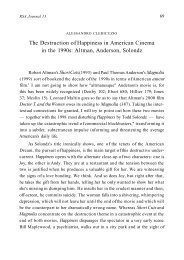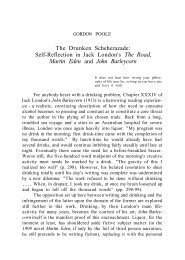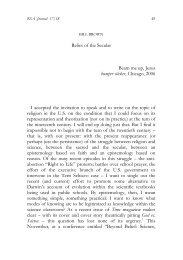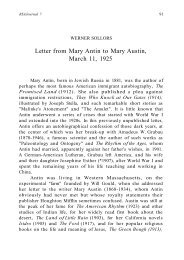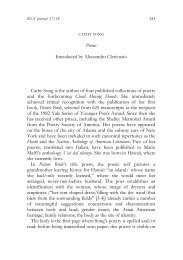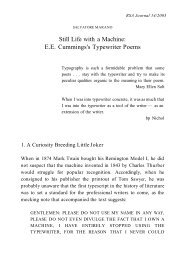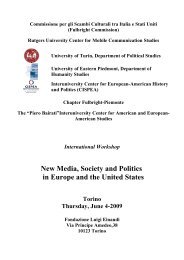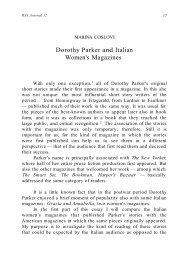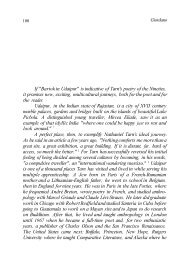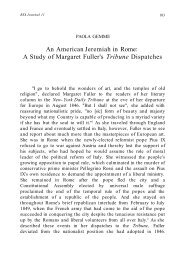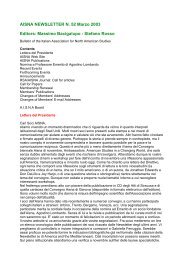Myth and Carnival in Robert Coover's The Public Burning - aisna
Myth and Carnival in Robert Coover's The Public Burning - aisna
Myth and Carnival in Robert Coover's The Public Burning - aisna
- No tags were found...
You also want an ePaper? Increase the reach of your titles
YUMPU automatically turns print PDFs into web optimized ePapers that Google loves.
RSA Journal 317Superhero Uncle Sam is able to control. What is power, then? Perhaps,as the last l<strong>in</strong>e of the quoted passage suggests, power is a mythicalsuperstructure that legitimates <strong>and</strong> condemns, blesses <strong>and</strong> executes, <strong>in</strong>the name of a religion of the State:<strong>The</strong>y [the Rosenbergs] never mention the afterlife, angels, or the HolyTr<strong>in</strong>ity... This ... has stirred the hearts <strong>and</strong> m<strong>in</strong>ds of American Superheroesfrom General George Wash<strong>in</strong>gton right down to the currentIncarnation, who is much given to visions of God work<strong>in</strong>g Hiswondrous will through the <strong>in</strong>vention of America. His Quaker VicePresident, lay evangelist <strong>and</strong> cleanser of the temple, has often echoedhim, <strong>and</strong> more: "Our belief must be comb<strong>in</strong>ed with a crusad<strong>in</strong>g zeal tochange the world!" (PB 105)<strong>Coover's</strong> implicit message is that violence is at the root ofAmerican society, coiled <strong>in</strong> the myth <strong>and</strong> <strong>in</strong>vention of America,transmitted like a disease from one Incarnation to another s<strong>in</strong>ce thetimes of the first Superhero, General George Wash<strong>in</strong>gton. Rather thana book on the fifties, <strong>The</strong> <strong>Public</strong> Burn<strong>in</strong>g is a novel that, through thespectacle of the fifties, reaches to the mythical archetypes at the centerof American power <strong>in</strong> an attempt to underm<strong>in</strong>e their hold.Why were the Rosenbergs burned? To answer this question,Coover leads us back to the orig<strong>in</strong>s of American society <strong>and</strong> to thefound<strong>in</strong>g myth of which present evil is only a belated emanation. Atthat time, "A trial [was] held under a tree, at which lads disguised assoldiers pronounce[d] sentence of death." This is not <strong>The</strong> <strong>Public</strong>Burn<strong>in</strong>g, it is Frazer's <strong>The</strong> Golden Bough. Just as <strong>in</strong> Frazer's ritual, thesentence aga<strong>in</strong>st the Rosenbergs is pronounced by Uncle Sam under"the Burn<strong>in</strong>g Tree," <strong>and</strong> aga<strong>in</strong> as <strong>in</strong> Frazer's regenerative rituals, theexecution of the Rosenbergs forms part of a ritualistic festival. Fromthe very open<strong>in</strong>g of the novel, <strong>Coover's</strong> symbolic sett<strong>in</strong>g organizes theexecution <strong>in</strong> terms of a Dionysian ritual of death <strong>and</strong> rebirth:[the execution] symbolizes fusion <strong>and</strong> organization, justice <strong>and</strong> temperament;the City is this year celebrat<strong>in</strong>g the tercentenary of its ownfound<strong>in</strong>g as New Amsterdam, its axis the Times Tower is <strong>in</strong> its SilverAnniversary year, <strong>and</strong> the Statue of Liberty—our Lady of the Harbor,Refuge of the Destitute, Ark of the Covenant, Reg<strong>in</strong>a Coeli, MotherFull of Goodness, Star of the Sea <strong>and</strong> Gem of the Ocean—is sixty-n<strong>in</strong>e;



